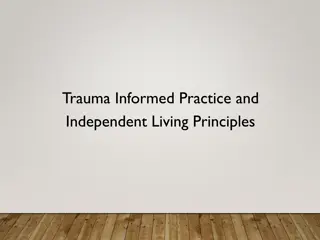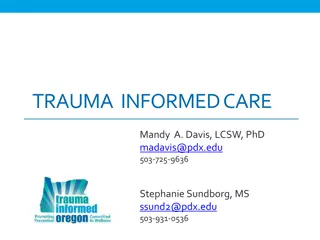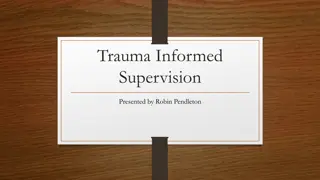Collaborative Approach to Trauma Care: A Comprehensive Guide
Explore the essential elements of treating clients experiencing trauma, including the role of case management, understanding provider responsibilities, considerations when interacting with clients, and a detailed treatment plan. Learn about measuring outcomes and success in various treatment settings.
Download Presentation

Please find below an Image/Link to download the presentation.
The content on the website is provided AS IS for your information and personal use only. It may not be sold, licensed, or shared on other websites without obtaining consent from the author.If you encounter any issues during the download, it is possible that the publisher has removed the file from their server.
You are allowed to download the files provided on this website for personal or commercial use, subject to the condition that they are used lawfully. All files are the property of their respective owners.
The content on the website is provided AS IS for your information and personal use only. It may not be sold, licensed, or shared on other websites without obtaining consent from the author.
E N D
Presentation Transcript
Treatment of Clients Experiencing Trauma A Collaborative Approach to Care May 9, 2018 * Tex-CHIP Training Series
Role of Case Management in the Treatment of Trauma Symptoms
Understanding Provider Role in Treating Trauma Treatment planning and review Psychoeducation Diagnosis education Treatment process education Medication education Mind/body connection Suicide Assessment and Safety Planning Teaching the client to self-advocate Teaching the client the importance of self-care Resources and Referrals Continuity of Care
Considerations when Interacting with Clients Cultural Considerations Client's support system or lack thereof Client's communication style and their ability to interact with other team members (self-advocate) Financial considerations and medical insurance Continuously assessing for unmet needs Resource limitations in the community Barriers to treatment- finances, insurance coverage, lack of support system, transportation, family obligations, time management, feeling unmotivated, alcohol and/or other drug use
Our Treatment Plan Healthcare Domain: Behavioral Health Provider: Case Manager Goals: Interventions: Objective: Provide alleviation of presenting trauma symptoms as indicated by client report of: (a) Intrusionsymptoms (b) Arousal symptoms (c) Avoidancesymptoms a) Self-care= symptom management a) 1. 2. 3. 4. Psychoeducation Treatment process Diagnosis education Medication education Mind/body connection b) Self-advocacy= access to resources c) Formal and informal support system=continuity of care and continued progress b) Skills training and review of coping strategies c) Planning for unforeseen stressors, triggers and/or barriers
Measuring Outcomes/ Success Dependent on limitations of the treatment setting Inpatient Psychiatric care Outpatient agency or private practice Higher Education Counseling Services Consistent review of the client's treatment plan Consistent review of the client's safety plan Asking the question , How will the client know they are ready to terminate treatment? How would the client s family/supports know they are ready to terminate treatment?
Communication from Counselors Additions/updates to the treatment plan Resources/referrals the client may need When client advocacy is needed from Case Manager Immediate safety concerns to update safety plan Any new or increase in alcohol and/or other drug use Medical challenge/s that may require a referral to an appropriate provider Any new legal problems























